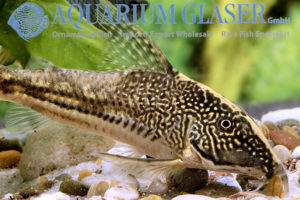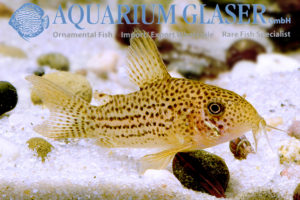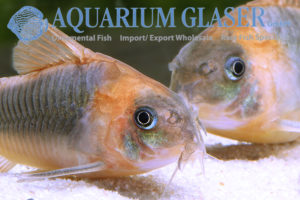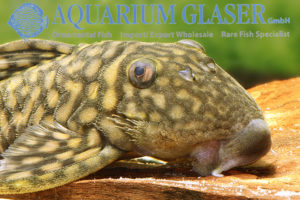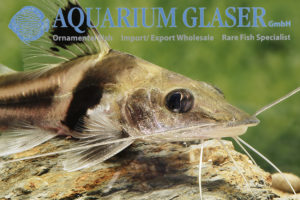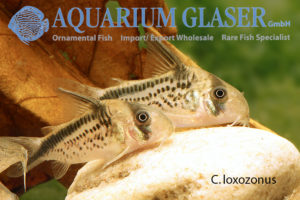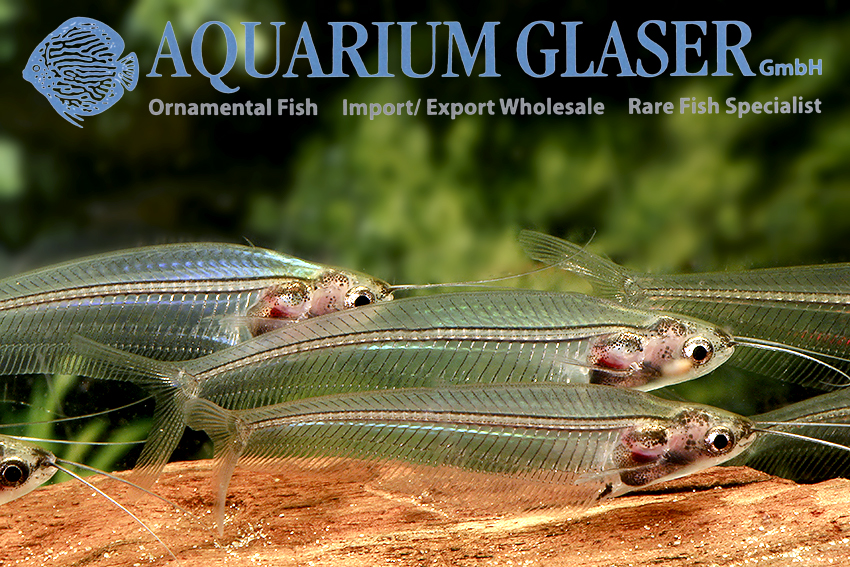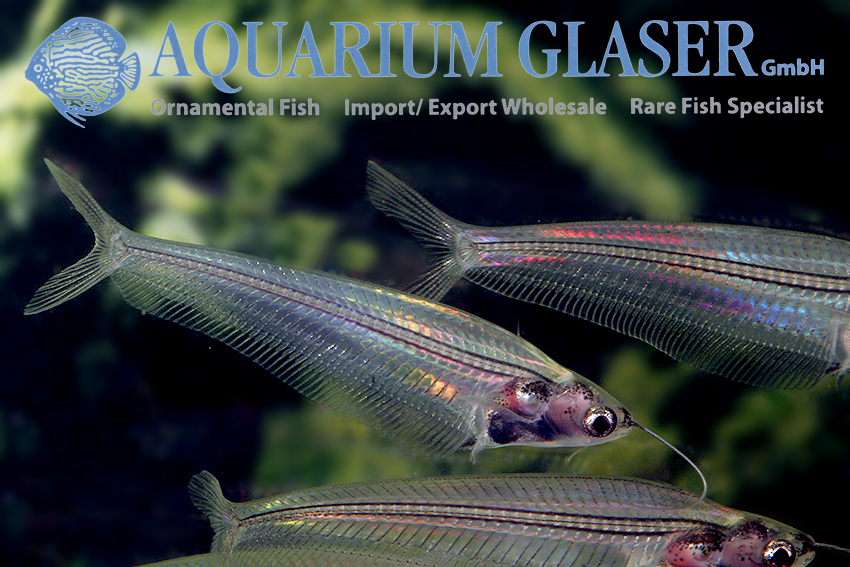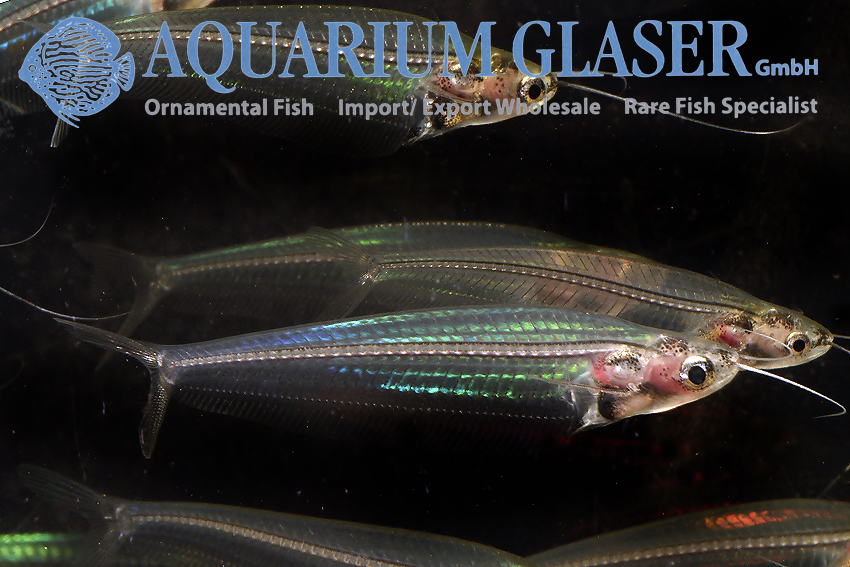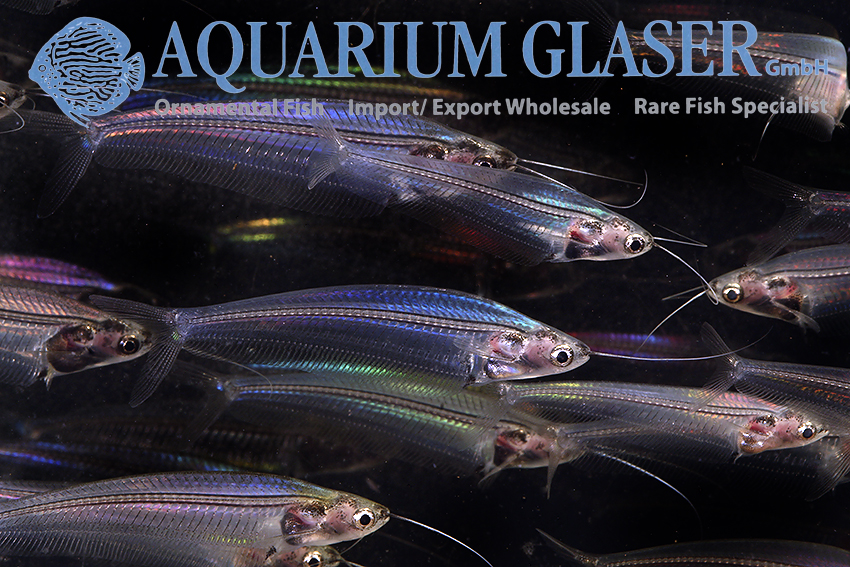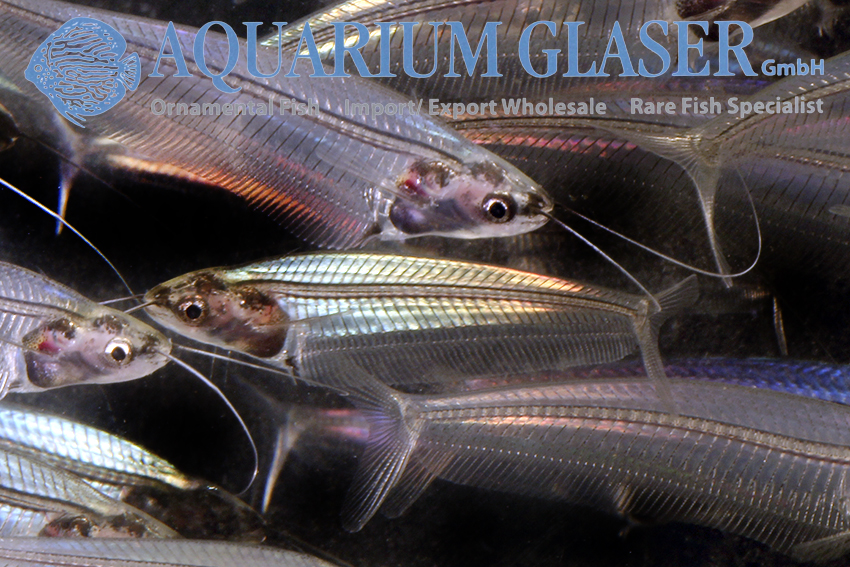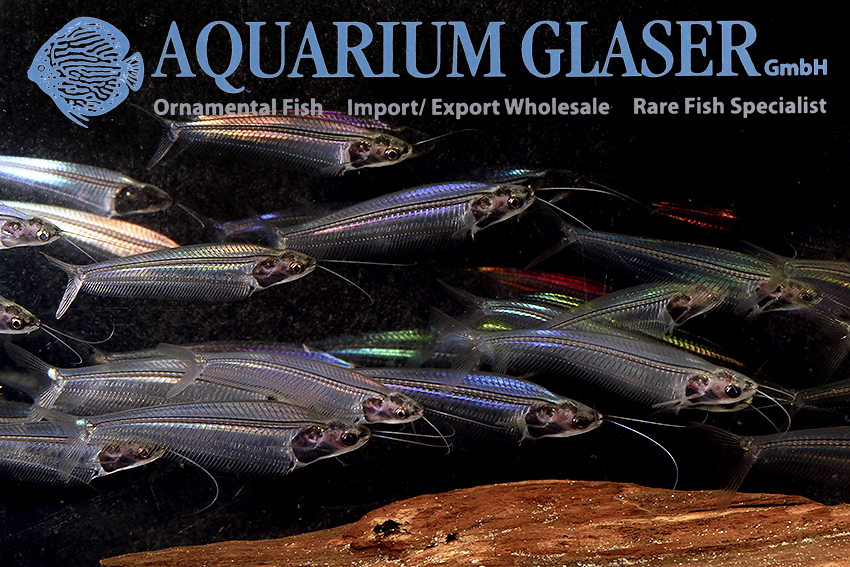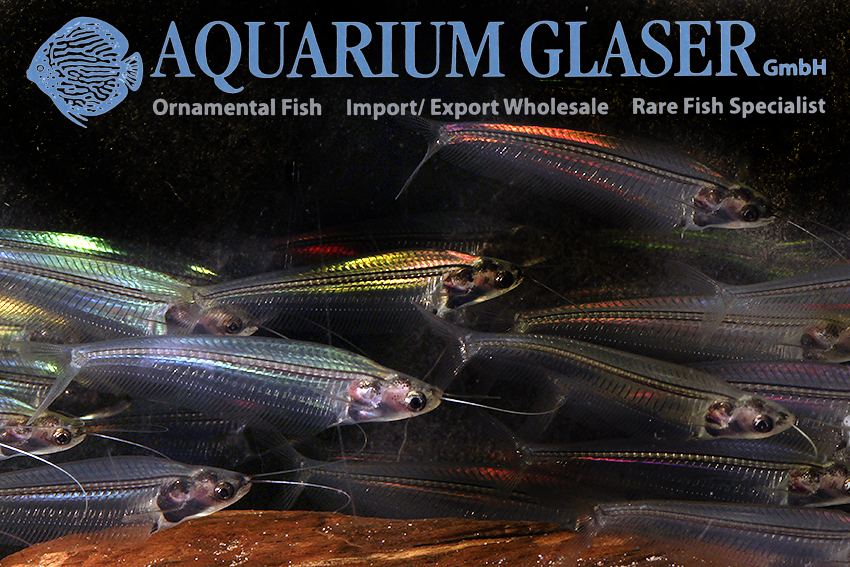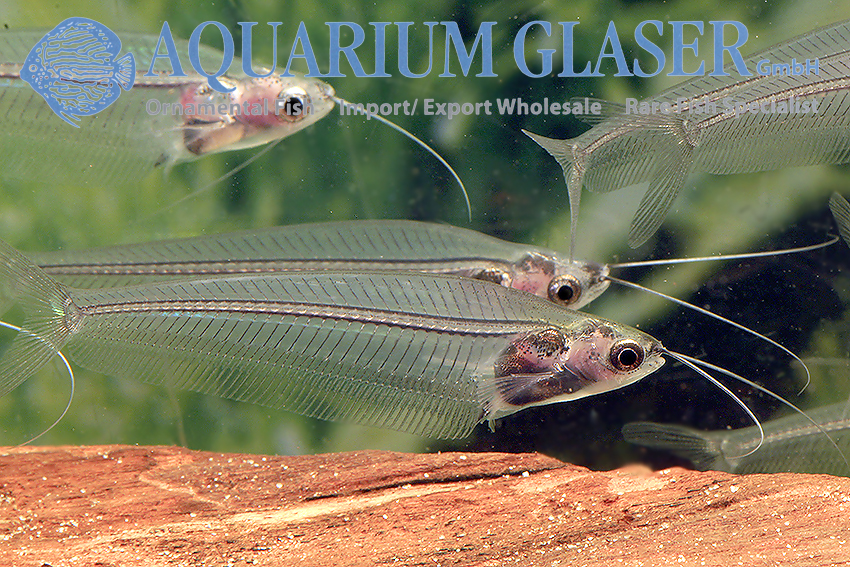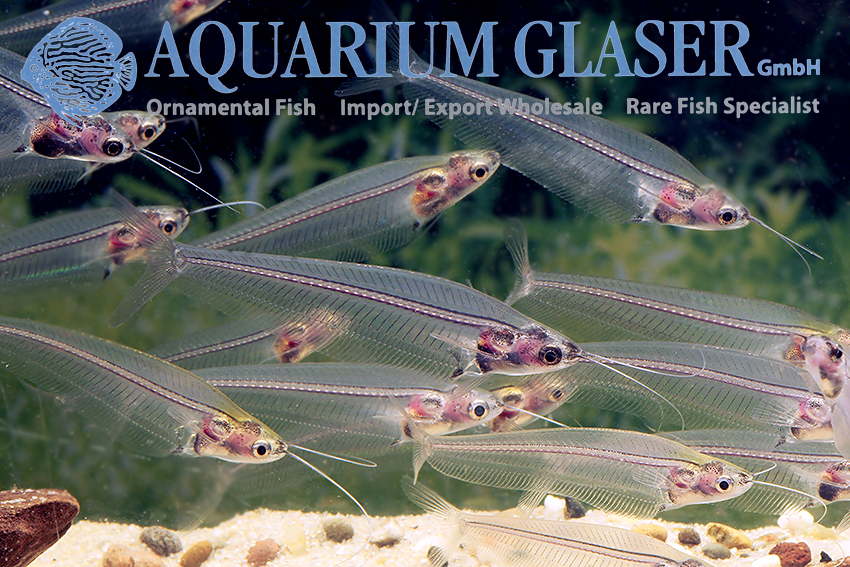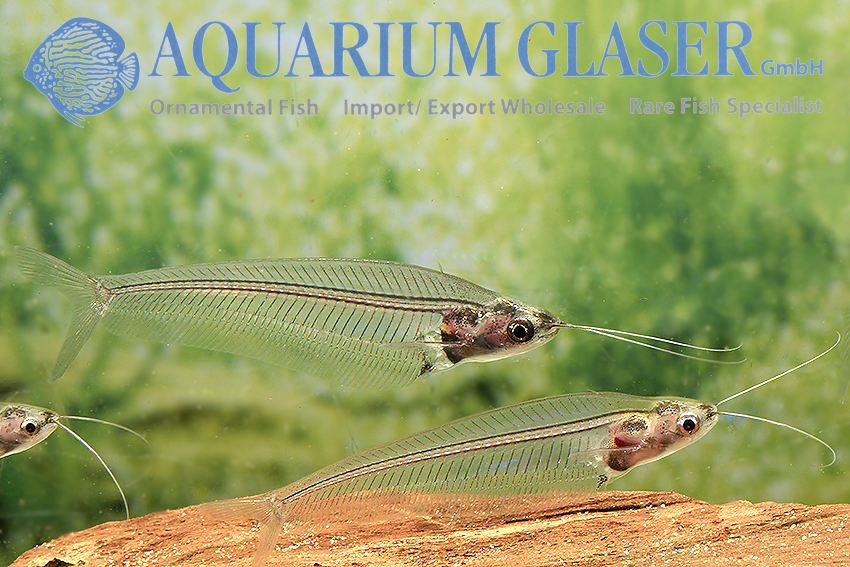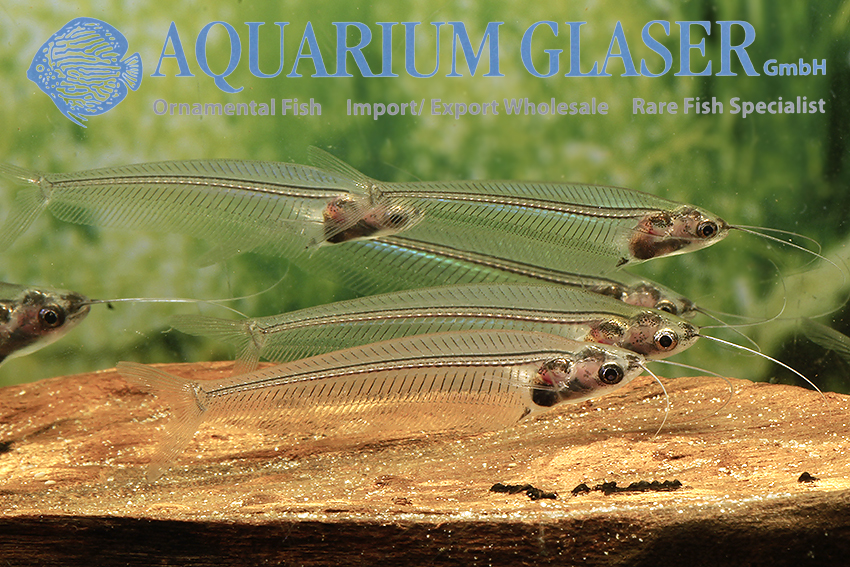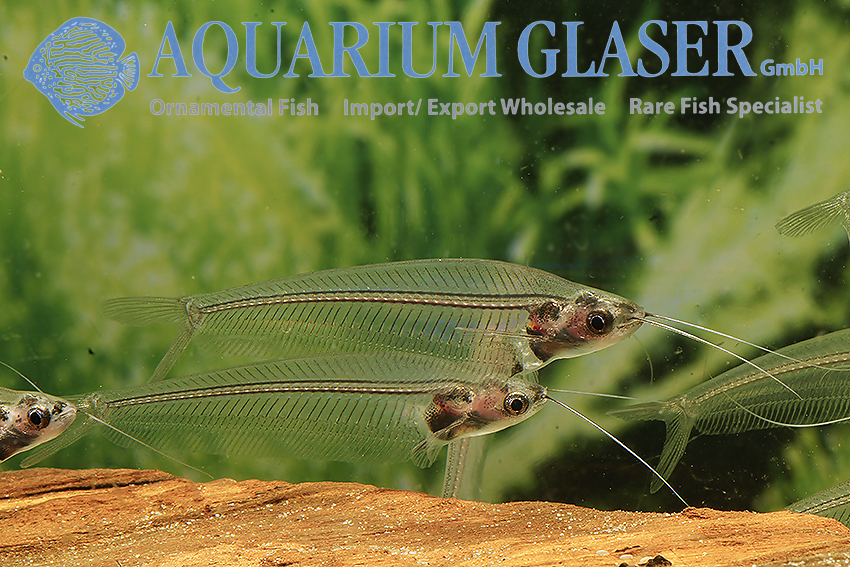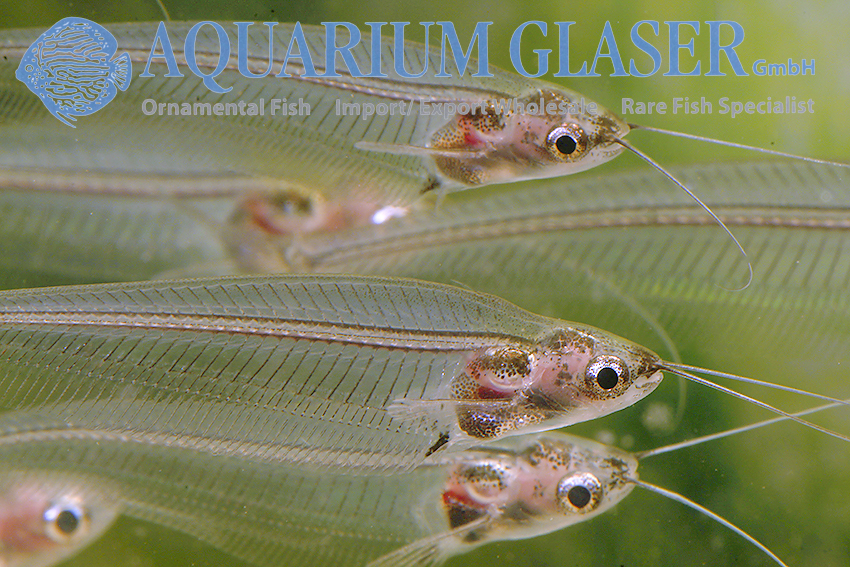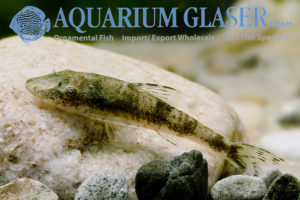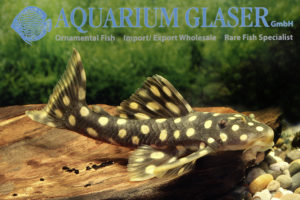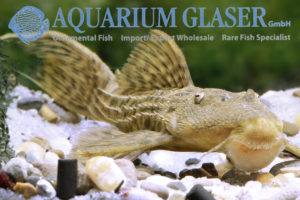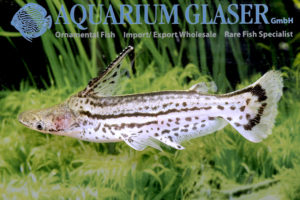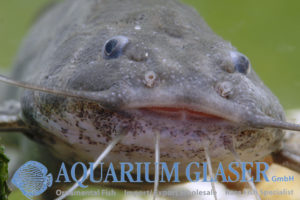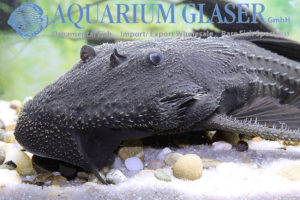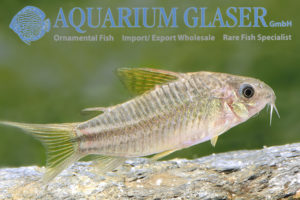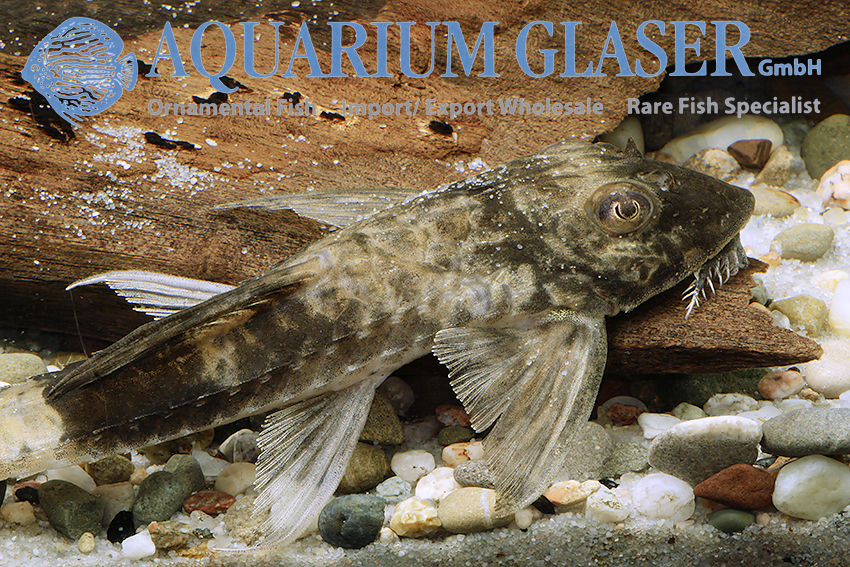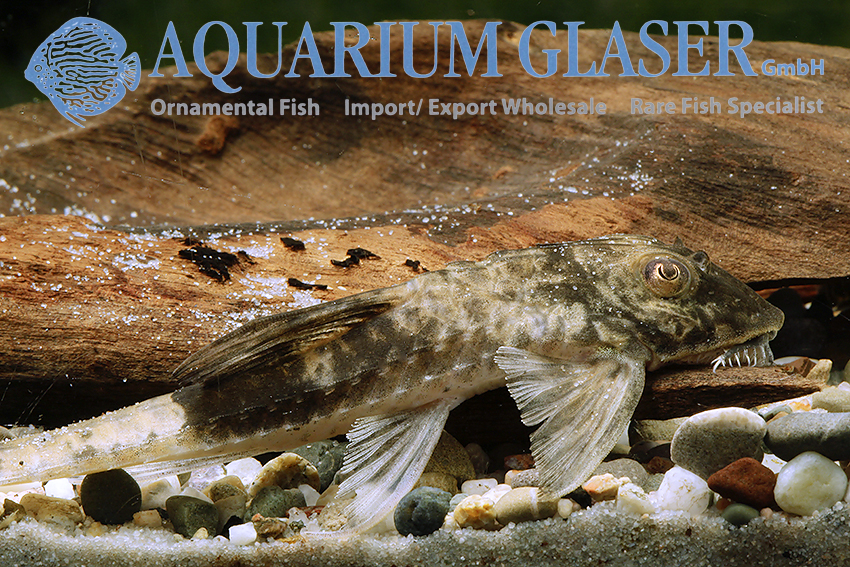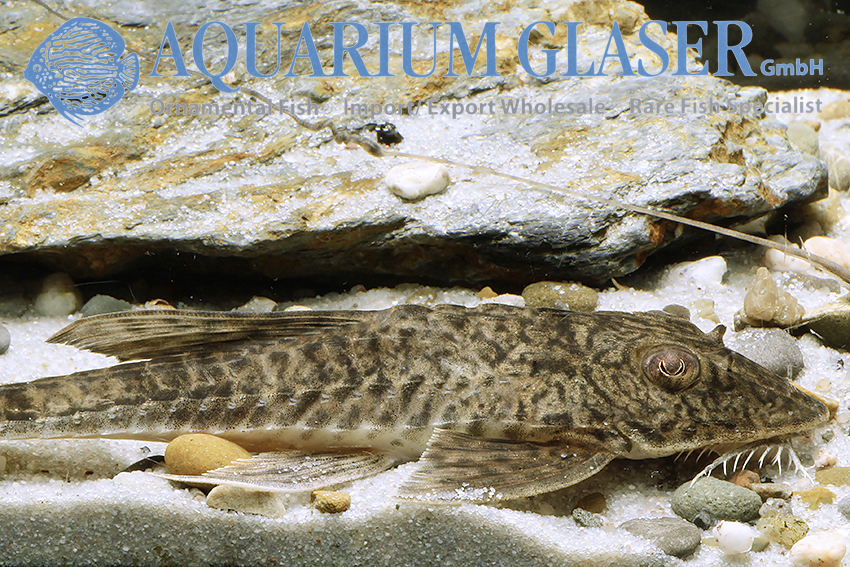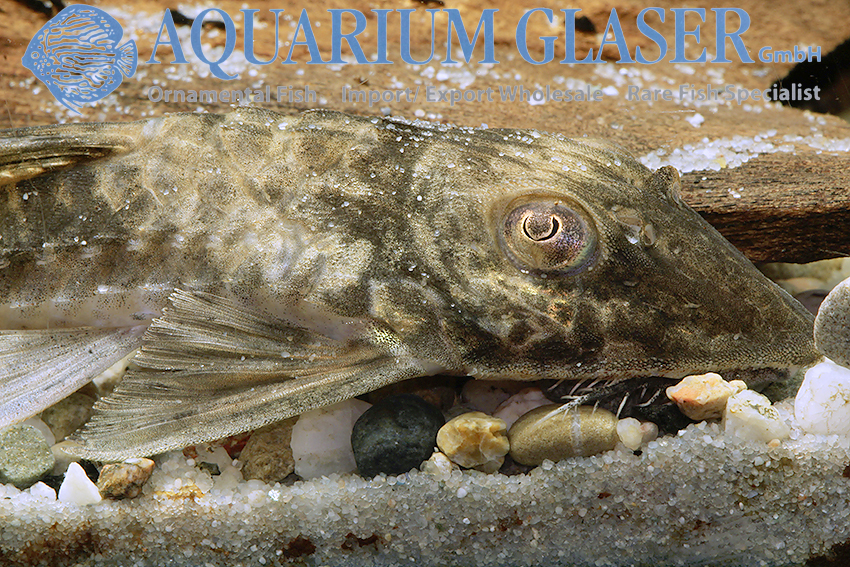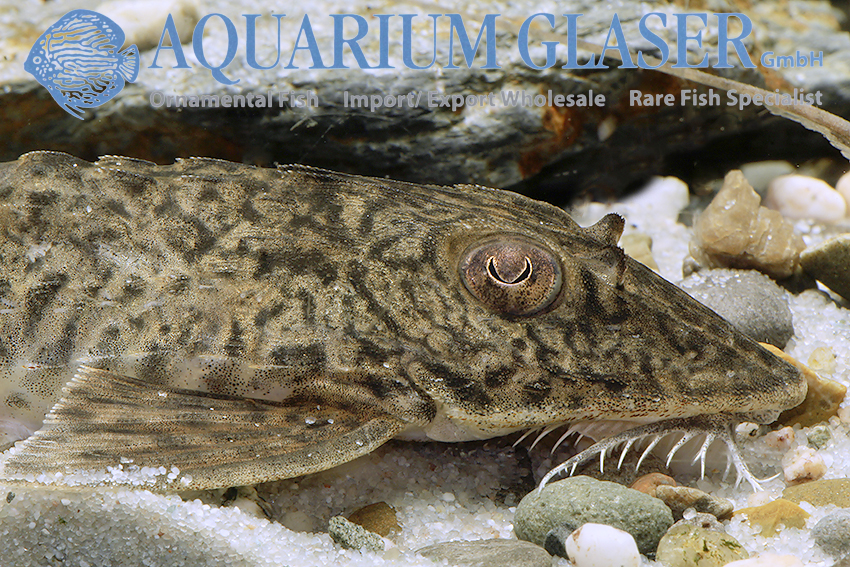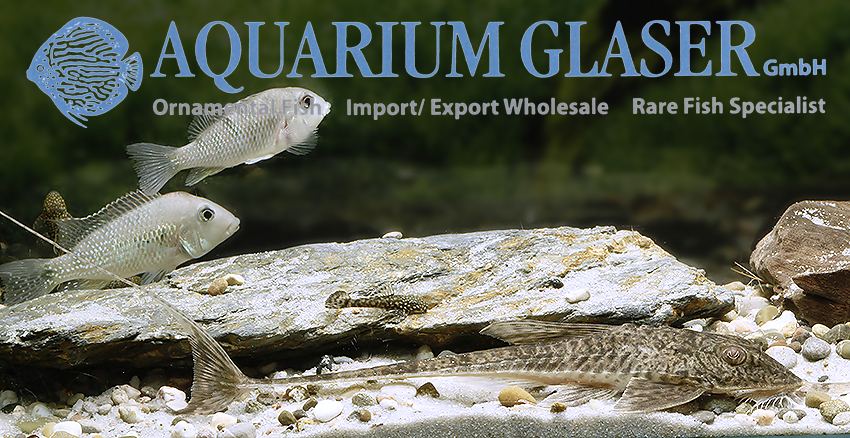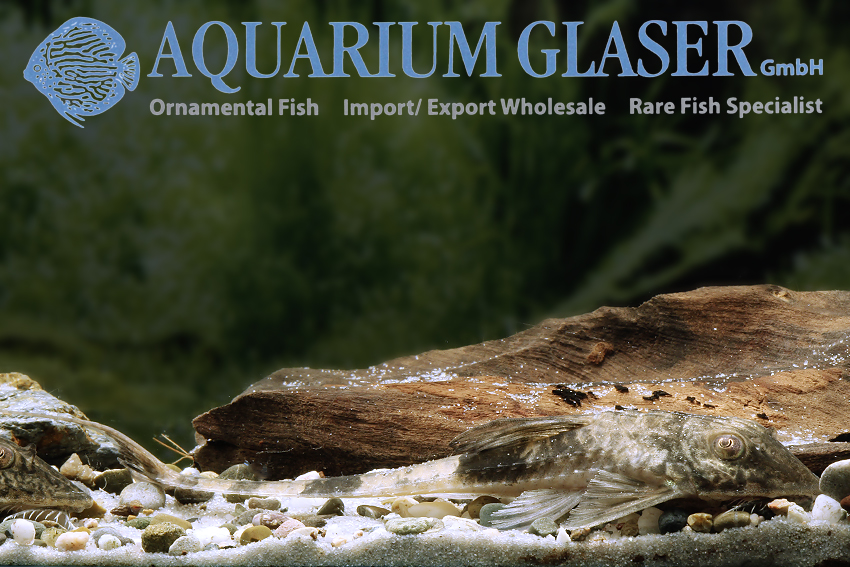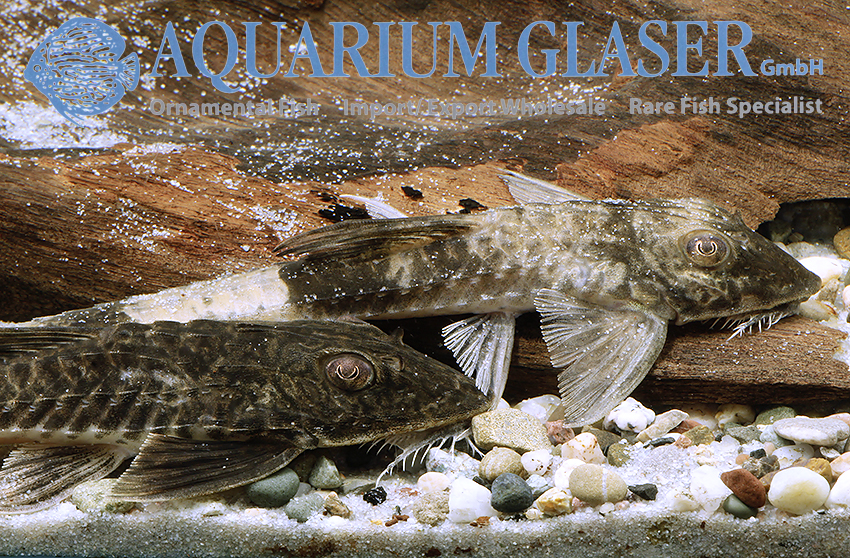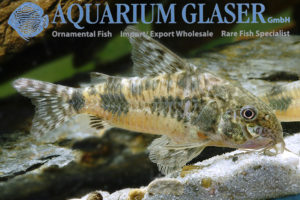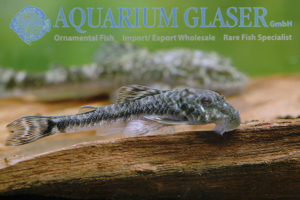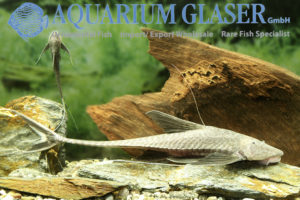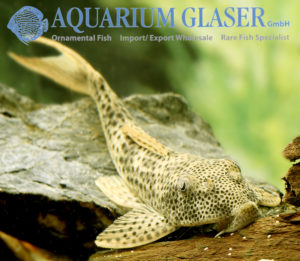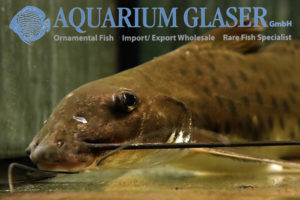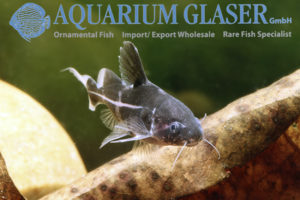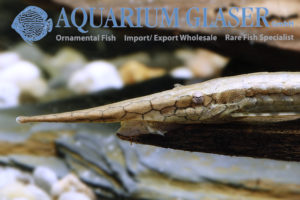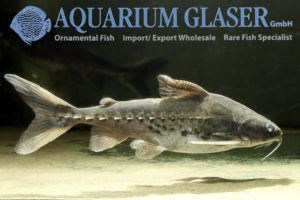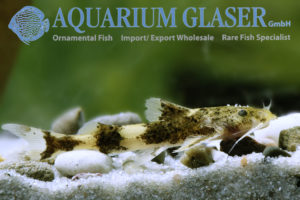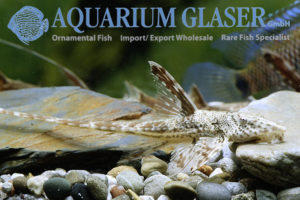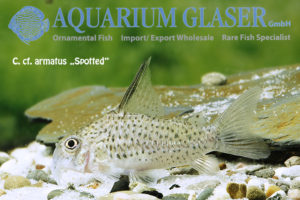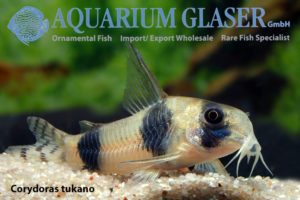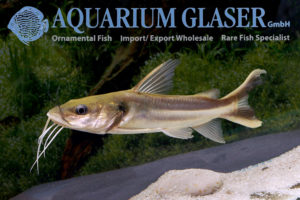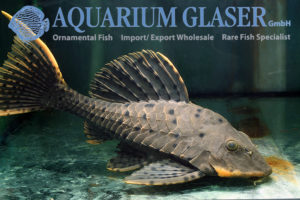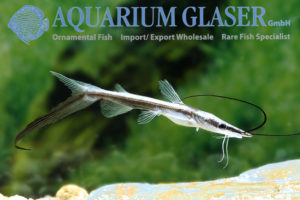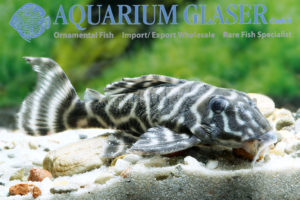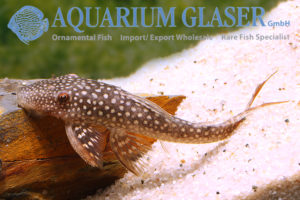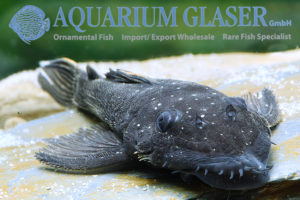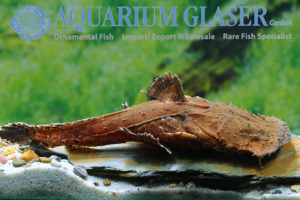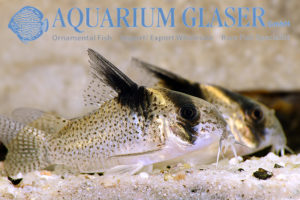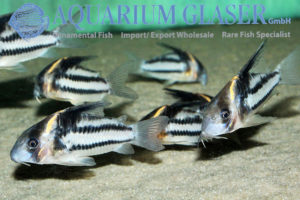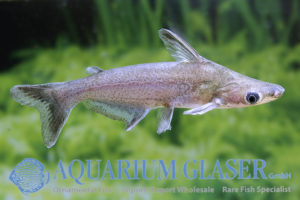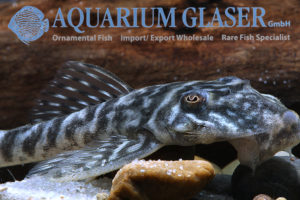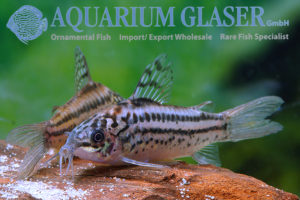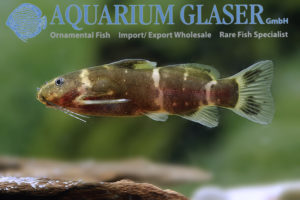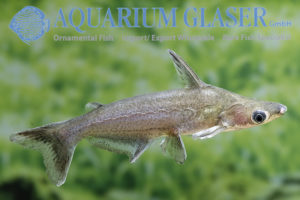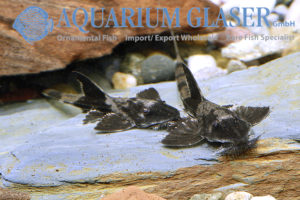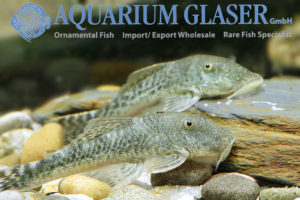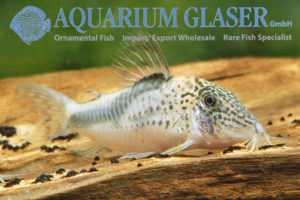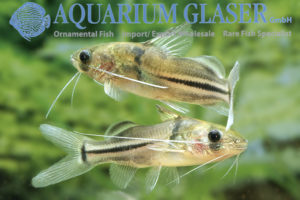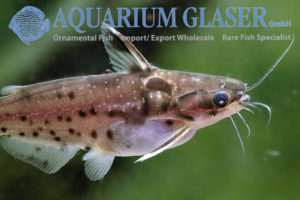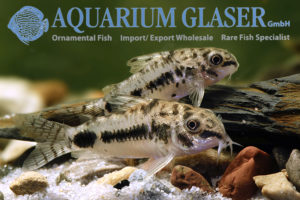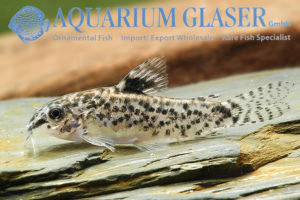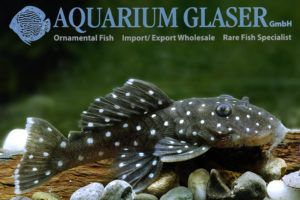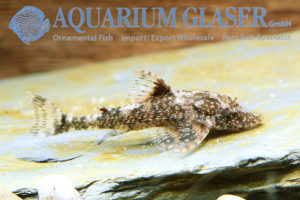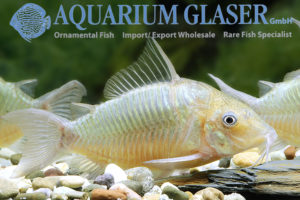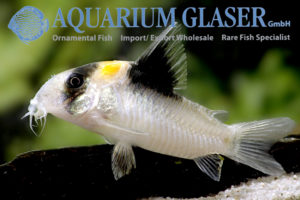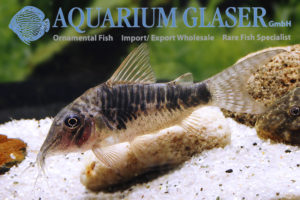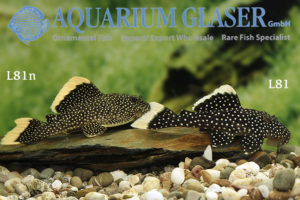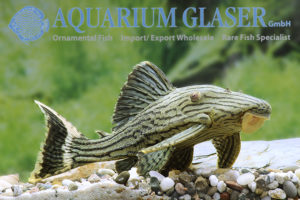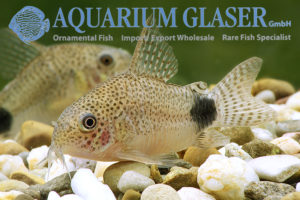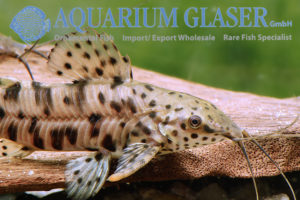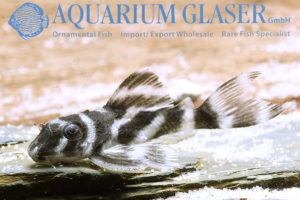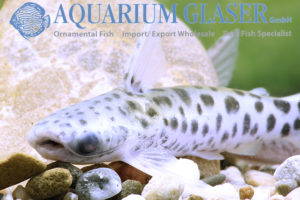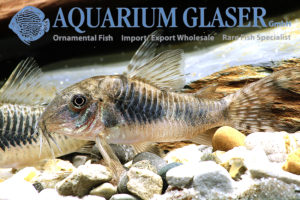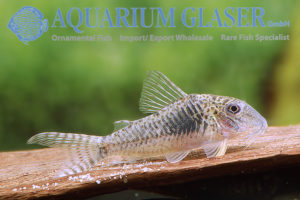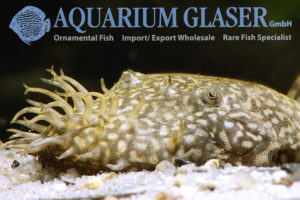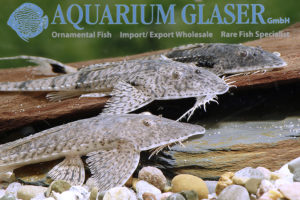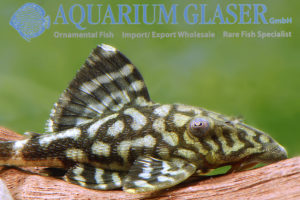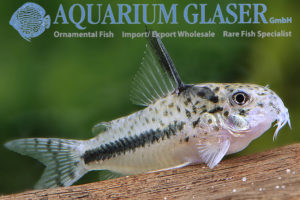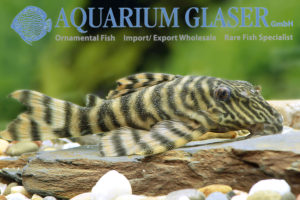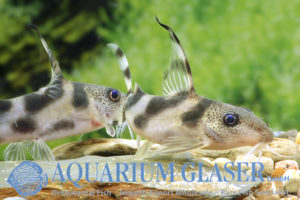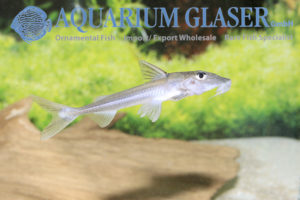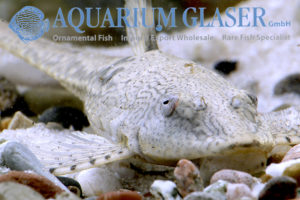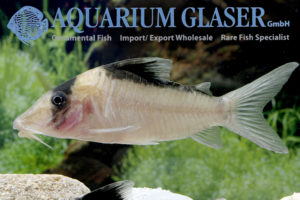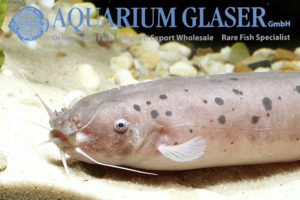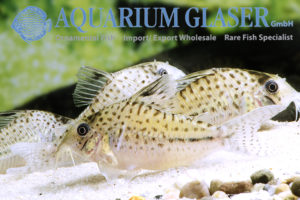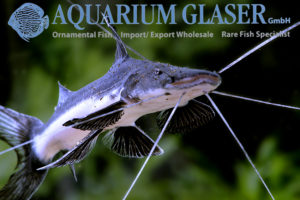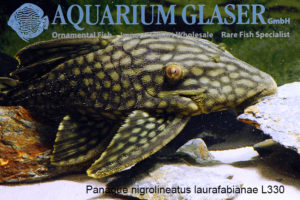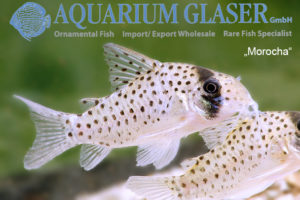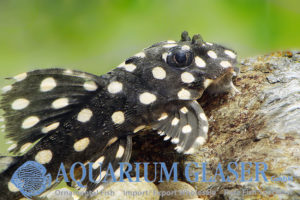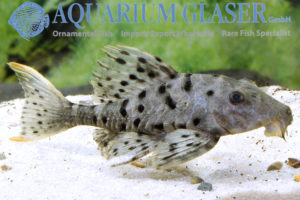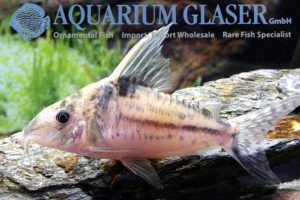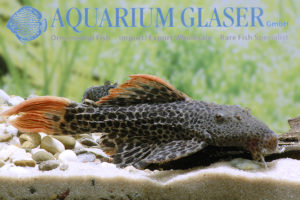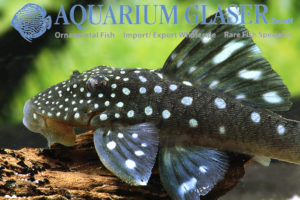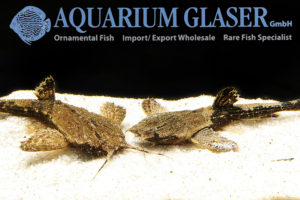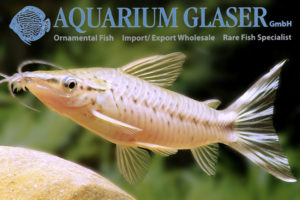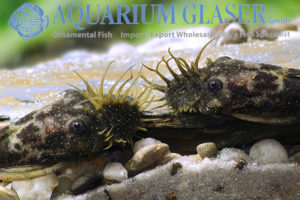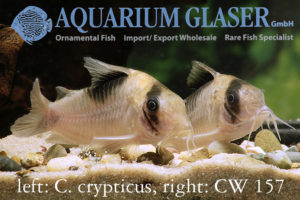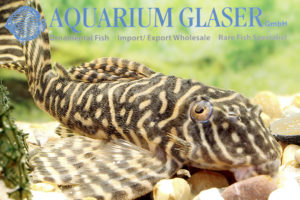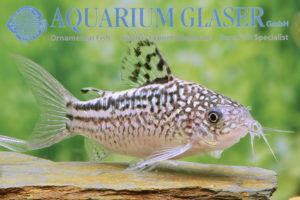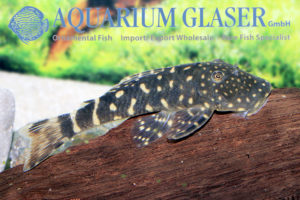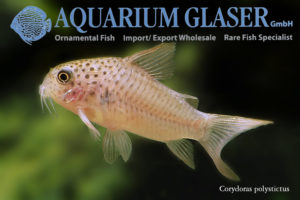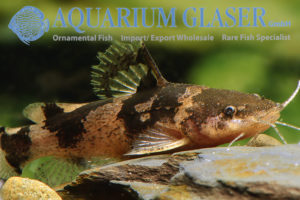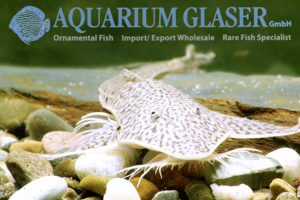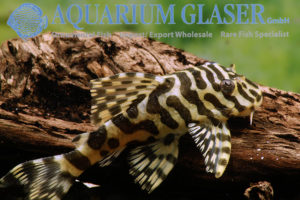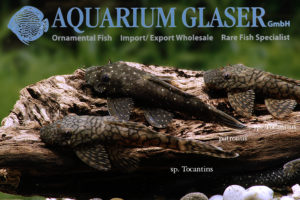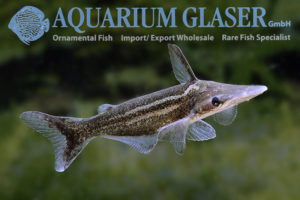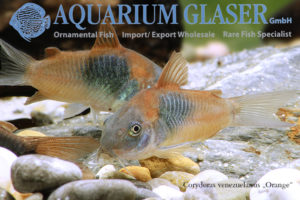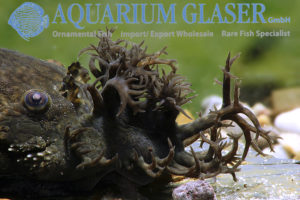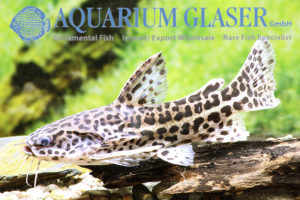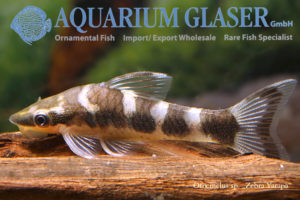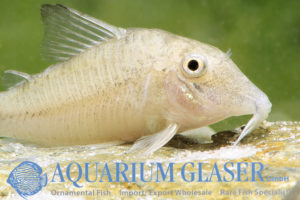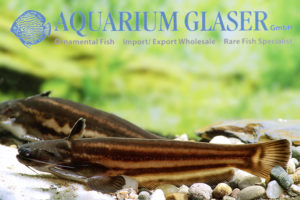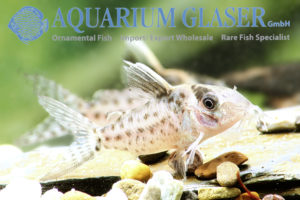The changed legal situation in Brazil now makes the import of several species from the south of Brazil possible again, which for many years were only available as offspring, among them the magnificent Scleromystax barbatus (formerly Corydoras b.). We have been able to import a good number of wonderful, fully grown specimens. For more information […]
10. Catfishes (748)
-
-
Corydoras eversi (C65)
The very nice Corydoras eversi lives in the Araguaia drainage (Brazil) and became known as C 65. It was only scientifically described in 2016. The scientific treatment of C. eversi is based on a collection by Hans-Georg Evers in 1998, who was also able to bring living animals with him. As mentioned, they were initially […]
-
Coryoras eques
From the Brazilian state of Amazonas, more precisely from the surroundings of the city of Anori, we once again received a good number of a beautiful armored catfish, which is known to science for a long time, but rarely appears aquaristically: Corydoras eques. This typical schooling Corydoras looks most attractive when kept in black water. […]
-
Spectracanthicus (= Oligancistrus) zuanoni L 354
Spectracanthicus zuanoni L 354 originates from Rio Xingu and the Rio Iriri in Brazil. It has been described scientifically only in 2014 (see http://www.aquariumglaser.de/en/archiv.php?news_id=1195). The fish belongs to the same species as L 20, with however clearly larger white marks, so that the design reminds of a black net on a bright background. The reddish, […]
-
Pimelodus ornatus
One of the most attractive large catfishes is Pimelodus ornatus, which is common in large parts of tropical South America. It is reported from the big rivers Amazonas, Orinoco and Parnaná, in addition the Guyana states. Maximum size reported is 38.5 cm (excluding caudal fin). The beautiful and lively fish is notorious for its venomous […]
-
Corydoras loxozonus and C. sp. aff. C16
Corydoras loxozonus belongs to the beautiful armored catfishes, which we receive relatively regularly from Colombia. The species is quite variable in pattern and therefore has already received the C-numbers C79 and C83. There was never any “proof” that these C-numbers really belong to the species C. loxozonus; this was only concluded from the fact that […]
-
Curculionichthys sabaji
A very long name for a very small fish! The genus Curculionichthys was established only in 2015 to accommodate dwarf sucker catfishes of the subfamily Hypoptopomatinae (formerly: Otothyrinae) of Loricariidae, which were previously placed in the genus Hisonotus. Both anatomical and molecular data showed that two independent evolutionary lineages existed within Hisonotus, namely that around […]
-
Ancistrini sp. L82
Among the species threatened by the construction of the Bela Monte Dam is L82, a species of loricariid up to about 15 cm long, which cannot yet be assigned to any genus described scientifically to date; it is most similar to Scobinancistrus. Also on species level L82 is not yet worked on. The only certainty […]
-
Pseudacanthicus sp. L79
This very flat Pseudacanthicus from the Rio Tocantins belongs to the rarest L-catfishes on the market. Even before the export ban by the Brazilian authority IBAMA, which was lifted only recently, the fish came to us only very sporadically. L79 certainly grows over 20 cm long, but exactly how big is unknown. Our animals are […]
-
Ageneiosus magoi
Males of all dolphin catfishes (Ageneiosus) develop huge dorsal fin spines and a penis-like mating organ at spawning time, also strange tooth-like looking papillae on the posterior margin of the upper jaw. They use the dorsal fin spine to clamp females for mating, and fertilization occurs internally. After spawning, the dorsal fin spine is shed […]
-
Wertheimeria maculata
Wertheimeria maculata belongs to the strangest thorny catfishes. You don’t see this on the relatively inconspicuous juveniles with their 6-8 cm length, but it is nevertheless so. The first thing that catches your attention is the really high price that is demanded for them. This is due to the fact that these fish are local […]
-
Acanthicus sp. L155 Furo Maguari
Acanthicus hystrix is one of the great myths in the literal sense. With a length of almost one meter it is one of the largest loricariid catfishes at all. In addition, the species, which was already described in 1829, is extremely prickly: “hystrix” means “porcupine”! Unfortunately, the specimen on which the description of this species […]
-
Corydoras elegans C123
The beautiful Corydoras elegans is widely distributed in the Amazon region and locally forms numerous color forms. Possibly all these variants are even independent species, but scientifically this has not been investigated yet. A color variant from the Rio Nanay in Peru stands out above all by yellow-orange tinted fins. Some males (they have higher […]
-
Coyrdoras paleatus wild
Only very rarely we receive wild collected Corydoras paleatus. Imports of this species, which is widespread in southern South America, didn´t appear for more than 10 years, because many export stations in southern Brazil had to close down when some of the most important ornamental fishes of the region were forgotten on the Brazilian positive […]
-
LDA25 Parotocinclus jumbo
The Pitbull Pleco (Parotocinclus jumbo, formerly Hypostominae gen. sp.) was one of the most popular small sucking catfishes until about 10 years ago. Then it was accidentally forgotten on the list of Brazilian ornamental fishes allowed for export. Since then, it has only been around in breeder circles. This species, very common in the wild, […]
-
Pterosturisoma microps
This interesting, about 20-25 cm long sucking catfish from Peru should only be kept by really experienced aquarists. Beside some adult specimens we could import this time also 4-7 cm long juveniles. The size of these fish is difficult to state, because one should not count the tail fin filaments, which are much longer than […]
-
Aphanotorulus sp. L11
The correct name of this beautiful catfish from the Rio Xingu is a matter of dispute among experts. In many parts of South America similar looking catfishes can be found, which are all close to the species already described in 1840 as Hypostomus emarginatus. These were assigned to the genus Squaliforma in 2001, and to […]
-
Pimelodina flavipinnis
We are proud to present this unusual first import. The rarity of this pretty large catfish in the hobby stands in strong contrast to the fact that it was scientifically described as early as 1876, is widespread (our animal comes from the Rio Negro in Brazil, but it also exists in the Rio Madeira, in […]
-
Bagrichthys macracanthus
We have received juveniles of the “Black Lancer” from Indonesia. The adult fish is pitch black with a white caudal fin and a narrow white horizontal stripe running along the middle of the body. The stripe begins below the dorsal fin and extends into the caudal peduncle. The 4-6 cm juveniles of this up to […]
-
Farlowella amazonum
The needle catfishes (Farlowella) are one of the most species-rich genera within the whiptail catfish relationship with currently 30 recognized species. The species look very similar to each other. Distinguishing features are mainly the arrangement of the bony shields along the flanks and on the abdomen, which is naturally hard to recognize on the living […]
-
Lithodoras dorsalis
The genus Lithodoras belongs to the thorny catfishes (Doradidae). There is only one species scientifically described, which has its distribution in South America: L. dorsalis, which inhabits the Amazon basin; in addition, the species was reported from a creek near Cayenne (French Guiana), but the latter occurrence still needs confirmation. The maximum length of L. […]
-
Glyptothorax cf. housei
The belly sucker catfishes (Glyptothorax) are almost unknown in aquaristics. It is a very species-rich group (over 100 accepted plus probably still numerous undescribed species) of mostly small, current-loving catfishes. The extremely sparse care experiences with these catfishes show that they are (as with many stream fishes) sensitive animals, which tolerate neither stronger organic pollution […]
-
Rineloricaria heteroptera
From Brazil we received beautiful whiptail catfishes, which we thought at first sight to be Rineloricaria lanceolata, a species with a very wide distribution. The high proportion of reddish animals was striking. The majority of the fish are small, 3-4 cm long and marked like R. lanceolata, but there are a few adult specimens among […]
-
Corydoras cf. armatus “Spotted Putumayo“
From Colombia we received a nice Corydoras species, which threw us into some confusion during identification. They were sent as C. armatus, a species described from the Rio Huallaga, a right-bank tributary of the Rio Maranon (the larger of the two headwaters of the Amazon) in Peru. C. armatus is a conspicuously high-backed species with […]
-
Corydoras reynoldsi & Corydoras tukano
Corydoras reynoldsi is a pretty cory catfish that has been described in 1960. It was collected in the Caquetà province, eastern Colombia. It remained unknown in the hobby quite long, as this area is far away from the usual collecting areas. In 1997 the cory enthusiasts became aware of another, quite similar species of Corydoras […]
-
Clarotes laticeps
This is one of the large river catfishes of Africa. We were able to import some specimens once more from Nigeria. However, the species has a very far distribution and is found in the Nile, most parts of West Africa and also in the rivers that flow through the savannahs and riparian forests of East […]
-
Pseudorinelepis sp. L95
Now it is again season for the unfortunately so rarely available Pseudorinelepis sp. L95 from the Rio Demini. And what beautiful animals we got! All specimens are 25-30 cm long. For more information please see https://www.aquariumglaser.de/en/fish-archives/pseudorinelepis-sp-l95-2/ For our customers: the animals have code 26480-L 095-7 on our stocklist. Please note that we supply only wholesale. […]
-
Sorubim lima
The large-sized species of the spiny catfishes (Pimelodidae) belong as adult fishes to the desired food fishes and not less desired species for fans of predatory catfishes with giant aquariums. As juveniles, these animals often look completely different and have, for example, absurdly long fin processes. The Shovelnose catfishes of the genus Sorubim are with […]
-
Hypancistrus sp. “Nhamunda” L475
The Hypancistrus catfishes with striped pattern are on the one hand a wonderful enrichment for the aquaristics, because they look beautiful, don’t grow too big and can be bred quite well, on the other hand they are constant cause for quarrel. Because in many cases it is hardly possible to determine them exactly. This is […]
-
Lasiancistrus heteracanthus
We were able to import the rare Red-eyed Deltatail-suckercat, Lasiancistrus heteracanthus, in small numbers from Peru. The species attains a total length of 15-18 cm. Besides the bright red eye the most striking feature of the species is the pretty brown-red lower lappet of the caudal fin. Lasiancistrus, in general, are good algae-eaters and fit […]
-
Ancistrus macrophthalmus LDA74
From time to time we receive a very flat-bodied Ancistrus from the Orinoco drainage in Colombia and Venezuela under the name of A. ranunculus/L 34. However, this species does not exist there, A. ranunculus is only known from the Amazon tributaries Xingu and Tocantins/Araguaia; the Orinoco species is Ancistrus macrophthalmus, which has received the LDA […]
-
Chaca bankanensis “Sumatra”
This week we received a good number of the interesting frogmouth catfishes of the species Chaca bankanensis from Sumatra. In contrast to the rather reddish animals we could import earlier (https://www.aquariumglaser.de/en/fish-archives/chaca_bankanensis_en/), this time they are rather brown-black colored, probably an origin-related color characteristic. Very interesting is that some animals have striking white colored eyes. At […]
-
Corydoras sp CW 98
This beautiful Corydoras belongs to a scientifically undescribed species. It originates from the upper Rio Negro in Brazil. Because of the bright orange neck spot it is usually misidentified as Corydoras burgessi, which also comes from this region, especially as C. burgessi has a very variable pattern and there are also spotted colour variants of […]
-
Corydoras sp. aff. parallelus CW127
Just as L-numbers are assigned for undetermined loricariids, C- and CW-numbers are assigned for undetermined Corydoras. One of the first species to receive such a number was Corydoras parallelus, which was assigned the number C2 in 1993. In the same year Burgess described it as C. parallelus. The species originates from the upper Rio Negro […]
-
Tympanopleura cryptica
For the first time we could (recognized) import this dolphin catfish from Peru. The small species (the biggest scientifically known animal had a standard-length – therefore without tail fin – of barely 8,5 cm) occurs in the area of the upper Amazon, where the river is still called Solimoes. Tympanopleura cryptica was described scientifically only […]
-
Pseudolithoxus kelsorum L189
Unfortunately this interesting catfish from Venezuela is offered only very rarely. It lives in the tributaries of the middle Orinoco. With a maximum length of 10 cm (only very rarely some specimens reach this size, the normal size is 6-7 cm) the species remains relatively small. Pseudolithoxus species are all quite flat, but P. kelsorum […]
-
Corydoras elegans
The armored catfishes of the closer relationship around Corydoras elegans belong to the most interesting species of this huge genus. They do not live as strongly bottom-bound as most other armored catfishes and are very nicely colored. Males and females differ relatively clearly in coloration. However, it is not easy to provide a color description […]
-
Microsynodontis batesii
Squeakers or upside-down catfishes are a fish family occurring exclusively in Africa. The best known genus is Synodontis, which comprises over 130 species. Closely related to this genus is the genus Microsynodontis. The genus name means “small Synodontis” and is program, because these fish already become sexually mature with 3-4 cm of length, are thus […]
-
Tympanopleura cryptica
For the first time we could (recognized) import this dolphin catfish from Peru. The small species (the biggest scientifically known animal had a standard-length – therefore without tail fin – of barely 8,5 cm) occurs in the area of the upper Amazon, where the river is still called Solimoes. Tympanopleura cryptica was described scientifically only […]
-
Lorcaria simillima Bred
Loricaria simillima has a very wide distribution in South America. It is found in the Orinoco-, Amazon- and La Plata basins. A result of this large area many different color forms are known, which differ clearly regarding coloration and pattern. The species occurs in different water types. Black water forms are more demanding in maintenance […]
-
Chaetostoma joropo (L445)
The dotted Chaetostoma joropo is already for many years a popular sucker-catfish. Before its scientific description in the year 2016 it was given several names, e.g. sp. Spotted, cf. milesi, Villavicencio I, L187a etc. It originates from creeks in the catchment area of the Rio Meta in Colombia and therefore does not need to be […]
-
Corydoras fowleri German bred
Corydoras fowleri from Peru becomes 6-8 cm long and certainly belongs to the most beautiful Corydoras at all. Nevertheless, the species is only rarely bred, because the eggs are relatively small and the fish – despite their size – relatively unproductive. Therefore we are especially pleased to be able to offer wonderful German bred ones […]
-
Brachyrhamdia meesi
The genus Brachyrhamdia includes only five described species, another one, that is still scientifically undescribed, was imported over 10 years ago as accidental catch, since then, one heard nothing more of it. Brachyrhamdia are relatively small-growing catfish. Brachyrhamdia meesi comes from Brazil and grows to about 8 cm in length. Like all species of the […]
-
Auchenipterichthys punctatus
It was believed for quite a long time that the genus Auchipterichthys would contain only one or two, very far spread species. In 2005 Ferraris, Vari, and Raredon revised the genus and could show that in reality four different species are involved. The species that was thought so far to be the most common in […]
-
Corydoras habrosus
Now it is season for the cute chessboard dwarf cory, Corydoras habrosus. The fish grows to a maximum of four centimeters. It is completely peaceful and leaves the plants in peace, so it is very suitable for community aquariums. The usual care-recommendations for Coryoras are valid, which means they should be kept in groups and […]
-
Aspidoras pauciradiatus
This cute dwarf armored catfish reaches a maximum length of only 3 cm. Aspidoras pauciradiatus comes from the central Rio-Negro area and is an ideal community fish for characins, dwarf cichlids etc. Strangely enough, the specimens on which the scientific description is based were allegedly collected in the Rio Araguaia near the town of Aruana, […]
-
Parancistrus nudiventris, L31, LDA4, Peppermint Pleco
This pleco from the Rio Xingu is an old friend, however, it received a scientific name only in 2005. It received the L-number 31 already in 1989. The genus Parancistrus is closely related to the genus Spectracanthicus; the formerly often used genus Oligancistrus is invalid and declared synonymous with Spectracanthicus. The only difference between Parancistrus […]
-
Parotocinclus eppleyi
One of the smallest loricariid species at all is Parotocinclus eppleyi, the Peppermint-Oto. The species is fully grown with a length of 3 cm (without caudal fin), but such animals can already be seen as xxl-format and are extremely rare. Usually the species, which is common in the upper and middle Orinoco, is 0.5-1 cm […]
-
Brochis splendens “Rio Negro
Via Manaus we have been able to import splendid Brochis splendens. The Emerald Cat comes from a huge area, from Peru to the Pantanal in Brazil; based on the experience with other Corydoras it is more than likely that there are several species hiding behind the name “Brochis splendens”. But such things should be subject […]
-
Corydoras burgessi
Now the season for the very beautiful and much beloved orange blotch corys has started. There does exist a good number of different species and varieties, all have in common a brightly shining spot on the neck. Depending on light this glows from yellow to almosr red. This glowing spot helps the fish in the […]
-
Corydoras sp. Souza, C124
We received very nice, fully grown specimens of this only very rarely available species from Peru. This species of Corydoras is very variable in respect of the pattern. However, we think the darkest animals are the males. For our customers: the fish have code 225215 on our stocklist. Please note that we exclusively supply the […]
-
Baryancistrus xanthellus L18, L81, L81n, L177
About from the end of May to the end of September the season of the beautiful Golden Nuggets of the genus Baryancistrus lasts. Although the fish are considered to be extremely common in nature, are also found in shallow water and have been used as food fish since time immemorial, they were only scientifically described […]
-
Panaque cf. titan Shampupa L418
The magnificent panaques of the nigrolineatus complex have long been sought-after aquarium fish. All species seem to grow around 40 cm long. One of the most spectacular species comes from Peru and was given the L-number 418. It is probably identical with the described species Panaque titan, but since this is not completely certain, the […]
-
Corydoras caudimaculatus Wild
From the Brazilian state of Mato Grosso, more precisely from the upper Rio Guaporé, comes the pretty Corydoras caudimaculatus, which reaches 5-6 cm in length. C. caudimaculatus is the most round-nosed and high-backed species of the “tail-spotted armored catfish”, which all have a similar pattern, but without being closely related to each other. The evolutionary […]
-
Megalechis thoracata
The Port Hoplo Megalechis thoracata – maybe the synonym (now invalid) name Hoplosternum thoracatum is more familar to some readers – is one of the earliest aquarium fish at all. The fish has only one real disadvantage: the maximum size, which is about 15 cm (or sometimes even larger). However, the species has a comparatively […]
-
Hypancistrus sp. L500
In northern tributaries of the Amazon, namely the Rio Nhamunda (L475), the Rio Padauari (L499) and the Rio Uatumá (L500), there are very similar Hypancistrus, which have a relatively stocky body in common. In colour they resemble very much the Hypancistrus furunculus (L199) from the upper Orinoco. All four Hypancistrus are extremely variable in colour, […]
-
Balroglanis schultzi (formerly Centromochlus s.)
The driftwood catfishes enjoy an increasing popularity, since it succeeds regularly to reproduce them. All species have – as far as known – an internal fertilization, the females spawn later without the presence of a male. Most driftwood catfishes are active at night or twilight. Many species are known to hunt land insects that have […]
-
Corydoras aurofrenatus
For the first time, we have this beautiful Corydoras, that was described already 1903 from Paraguay, as bred ones in stock. However, there is no possibility to distinguish the Corydoras aurofrenatus from C. ellisae, which was also described from Paraguay in 1940. Therefore both species were synonymised by Axenrot and Kullander in 2003, the name […]
-
Corydoras sp. “Peru”
Sometimes it is coincidence that determines whether a fish species can establish itself in the hobby. In the case of this Corydoras sp. Peru, a Corydoras fan noticed the fish when visiting a wholesaler; they were so-called by-catches that had been sorted out. Unfortunately, the wholesaler could not remember exactly where the animals originally came […]
-
Ancistrus claro
One of the smallest Ancistrus species is Ancistrus claro, which was known as LDA 8 before its scientific description. The catfish originates from clear water streams with a strong current in the upper part of the Rio Paraguay-Paraná river basin and becomes at most 6-8 cm long. The sexes are not quite as easy to […]
-
Pseudohemiodon laticeps
Pseudohemiodon laticeps from Paraguay belongs to the longest known mouth-breeding Whiptail Catfish in the hobby, even if this large (up to 35 cm) species with its species-specific broad, triangular head was confused for a long time with the very similar, narrow-headed species P. platycephalus from Brazil. Mostly one sees both species in a fawn-brown colouring […]
-
Panaque schaeferi L203 L90c
Among the largest loricariid catfish are some of the wood-eating Panaque species. Panaque schaeferi is one of them, the species will certainly grow to about 60 cm long. Since P. schaeferi was described on the basis of adult specimens, the assignment to the young animals belonging to it has never been scientifically confirmed. However, it […]
-
Corydoras sipaliwini
There are three beautiful, very closely related, small (4-5 cm) armored catfish species on the Guyana Shield in South America, which look so similar to each other that they have already been seen as synonymous with each other in the past: Corydoras bondi, C. coppenamensis and C. sipaliwini. However, most lovers of Corydoras share the […]
-
Panaqolus sp. L2
The tiger pleco was already imported and presented in 1988; since then, unfortunately, no scientist has yet taken a closer look on the beautiful animals imported from Rio Tocantins in Brazil for the hobby; therefore, this relatively small, maximum 12 cm long, peaceful loricariid catfish still has no “correct” name, but has to be content […]
-
Synodontis decorus
One of the most beautiful squeaker catfish (Synodontis) comes from the Congo: Synodontis decorus. The slender species grows about 20-30 cm long and is relatively peaceful. One must always consider that all squeaker catfish have a hierarchy among each other, where “social biting” is absolutely necessary and not alarming, since it only comes to superficial, […]
-
Leptodoras cf. cataniai “Rio Nanay“
We receive only very rarely imports of one of the unusual and stress-prone Leptodoras species. These thorny catfish are extraordinarily elongated and apparently live in flowing waters, while many other thorny catfish – think of the Platydoras, Agamyxis etc. which are common in the hobby – are more at home in dead wood or leaves […]
-
Sturisomatichthys leightoni
Until recently, two genera of closely related whiptail catfish were distinguished according to anatomical features: the relatively short-nosed Sturisomatichthys with four described species and the relatively long-nosed Sturisoma with over 15 species. All species are popular aquarium fish because they are attractive and easy to breed. Unlike most other loricariid catfish they do not breed […]
-
Corydoras cf. imitator C140 Red Spot
Again and again we receive imports of Corydoras from the upper Rio Negro area, which differ in details from the well known Corydoras adolfoi, C. duplicareus, C. imitator, C. serratus & Co. It is difficult to classify them in such cases. Are these only colour variations that occur in large numbers somewhere? Are they geographically […]
-
Malapterurus beninensis – Electric catfish
For a long time it was believed that there were only two species of electric catfish, namely the widespread Malapterurus electricus and the Congolese M. microstoma. Then two independent revisions of the genus appeared practically at the same time, one by Roberts (2000) and one by Norris (2002), which drastically increased the number of species, […]
-
Corydoras orphnopterus
216 scientifically described Corydoras species, of which 163 are generally accepted as valid (this number is, of course, constantly changing, as of March 2020), 159 C-numbers and 160 CW-numbers: one should think that gradually all Corydoras are sufficiently known. But there are still several species which are known only because of their scientific description and […]
-
Brachyplatystoma platynemum
From Peru we have received some specimens of this very rarely imported catfish. The animals are in top condition and currently 10 – 12 cm long. Brachyplatystoma platynemum used to be placed in a separate genus, Goslinia, which is now a synonym for Brachyplatystoma. B. platynemum is distributed throughout the Amazon and Orinoco region and […]
-
L330 scientifically described: Panaque nigrolineatus laurafabianae
Many fish scientists (ichthyologists) currently reject the concept of the subspecies. They argue that either there are definable characteristics, in which case it is a species, or there are no characteristics, in which case the form cannot be named. However, this concept has only limited relevance to reality; in the case of the large striped […]
-
Corydoras cf. atropersonatus “Morocha“
For the first time ever we have received a very attractive Corydoras (called „Moriocha“) from Peru (unfortunately not more details), which looks very similar to Corydoras atropersonatus (this species also comes from Peru – Rio Nanay basin – and we have received this at the same time), but is even more attractive. Corydoras atropersonatus has […]
-
Hypancistrus sp L471 “dwarf, big spots”
From the Rio Ventuari in Venezuela we have received this extraordinarily beautiful Hypancistrus, which is very similar to H. inspector, H. contradens and L201, but has considerably larger spots, which also appear slightly yellowish. At least wild collected L471 seem to remain much smaller than the other mentioned Hypancistrus and hardly grow beyond 6 cm. […]
-
Pseudorinelepis sp. L95
The loricariids of the genus Pseudorinelepis are the most heavily armored loricariids at all. They are widely distributed in the basins of the large South American rivers Amazon and Orinoco. The imported animals often look a little bit different, but scientifically only one species, P. genibarbis, is recognized at present. The coloration varies greatly individually, […]
-
Corydoras robustus
This Corydoras belongs with 9-10 cm of total-length to the biggest and most splendid species of the genus at all. Both sexes develop, when they are sexually active, long dorsal fins. The males can be recognized by the additional long ventral fins. At the moment we have wonderful, fully grown, well settled animals in stock. […]
-
Pseudacanthicus leopardus LDA7
Species of Pseudacanthicus are also known under their popular name “cactus catfish”, for the species are very spiny and it is no good idea to catch a larger specimen with bare hands. Some species of Pseudacanthicus can reach one metre in length, but there are other species that grow up only to 25 cm. As […]
-
L128 Blue Phantom
There is no „official“ paper that states in which genus this popular species from Venezuela should be placed in, but the catfish community agrees that it most probably is a member of the genus Hemiancistrus. Currently we have very nice youngsters of 3-4 cm length in stock, and some smaller as well as some larger […]
-
Bunocephalus coracoideus
Banjo catfish (Bunocephalus) are very common in nature. That is why we always have them on offer. Mostly we call them Bunocephalus coracoideus, which may be correct in many cases. But if you look into such a swarm of banjo catfish you will notice that there are always other species in between. Usually they cannot […]
-
Dianema urostriatum
The most beautiful species of the Callichthyinae relationship is undoubtedly Dianema urostriatum. The striking black and white striped caudal fin indicates its origin: water coloured dark brown by humic substances. Here, fish that prefer to live in groups need signals that allow them to recognize themselves even in poor visibility. Cardinal tetras, which live in […]
-
Ancistrus leucostictus
From the Guyana states (French Guiana, Guyana and Surinam) there are for various reasons hardly any commercial ornamental fish exports. The ornamental fish originating there, e.g. the glow-light tetra, are therefore practically exclusively traded as bred specimens. This is also true for Ancistrus leucostictus, which was brought back from a tributary of the Mazaruni River […]
-
Corydoras crypticus and Corydoras cf. crypticus CW 157
The high number of varierties of Corydoras in the upper Rio Negro is very confusing and even Corydoras experts in some cases have great difficulty in addressing the very similar species. A controversial species from the beginning is Corydoras crypticus, which was described together with C. amandajanea in 1995. The main difference between C. crypticus […]
-
Hypancistrus spec. L 401
This in the DATZ 12/05 newly introduced very beautiful Hypancistrus variant is currently available in small quantities. The animals remind in their habitus of L 333 and are sometimes confused with them. All in all L401 are more dainty, somewhat more stretched and reach only a total-length of maximum 12 cm, while L 333 can […]
-
Corydoras elegans “Peru”
There are several species of Corydoras, which even pronounced specialists are not able to distinguish. In such cases it might be useful to speak of species groups instead of species. One such example is the species group around Corydoras elegans in the narrower sense, which includes C. elegans, C. napoensis, C. nanus and several C- […]
-
Chaetostoma sp. L455 Tiger
After longer time we could import again the beautiful Chaetostoma sp. L455 Tiger from Peru. Generally speaking, Chaetostoma species do not stand out because of their attractive colors, but this species makes a clear exception – at least the males. The females are colored considerably simpler. Some specimens show a red coloration in the tail […]
-
Corydoras polystictus and C. albolineatus
We currently have two rarely available species of Corydoras in stock, which look very similar to each other: Corydoras polystictus and C. albolineatus. The former has a wide distribution in southern South America, while the latter was discovered comparatively late and described from the Rio Itanez in Bolivia. However, our specimens come from the Brazilian […]
-
Microglanis carlae
Usually the „typical“ catfish with long barbels become quite big and are therefore also called “predatory catfish” in the hobby. The lovers of these animals therefore have really large aquariums to care for their favourite fish. However, there is a species from South America, more precisely from Paraguay, which is truly also suitable for nano […]
-
Pseudohemiodon sp. Peru II German Bred
Floundercatfish are very popular with catfish lovers because they combine an interesting appearance with the interesting mouth brood care. Some species become quite big, so P. laticeps from Paraguay, that can become well and gladly 35 cm long, but there are also smaller species. Among the latter are two scientifically seemingly not yet described species […]
-
L134 Peckoltia compta
The L-number catfishes are like us humans. There are pretty, very pretty and extraordinarily pretty specimens. To the latter group belong the L134 (Peckoltia compta) from the Rio Tapajós, which we currently have in stock. P. compta belongs to the most recommendable L-catfishes at all and unites all desired characteristics of this group in ideal […]
-
Ancistrus patronus and Ancistrus sp. “Rio Tocantins”
In small numbers we received German bred specimens of these pretty bristle-noses. Ancistrus patronus is one of the numerous white dotted, black species and was known in the hobby as Ancistrus sp. “Puerto Ayacucho” and A. sp. “Rio Parucito” before its scientific description in February 2019; the numbers L125 and L150 were given to imported […]
-
Ageneiosus lineatus (= sp. III Green Stripe)
Update: es handelt sich um die Art Ageneiosus lineatus Ribeiro, Rapp Py-Daniel & Walsh 2017 The dolphin catfish were only recently revised and divided into two genera: Ageneiosus and Tympanopleura. Tympanopleura are the smaller species. They are characterized by a circular structure immediately behind the edge of the gill cover, which looks like a tympanum. […]
-
Corydoras venezuelanus “Orange” and C. sp. “Venezuela Black”
Such a pretty little fish and such an ugly confusion about the name! Corys, which look like the bronze cory, Corydoras aeneus, appear in whole South America. However, these are certainly different species, there is general agreement. Only – how to name them correctly? Whether the cory, which is currently called Corydoras venezuelanus “Orange” in […]
-
Ancistrus sp. Paraguay
After Paraguay had closed its doors for half a year for the export of ornamental fish, now imports from the southern country in South America reach us again. Among them also various Ancistrus species, which are often sent mixed. It has become common practice in the trade to call these animals Ancistrus tamboensis, which is […]
-
Liosomadoras oncinus
The Jaguar catfish (Liasomadoras oncinus) belongs to the rarities in the aquarium. Also in the large museum collections of the world the species is only sparsely represented, so that the knowledge about these animals is small. In the aquarium, they belong to the very sensitive species that only experienced aquarists should dare to approach. The […]
-
Zebra Otocinclus
Currently we have two forms of very attractive Zebra-Otocinclus from Peru in stock. The first species, Otocinclus cocama, is more commonly available. It shows a rather dense pattern of vertical black stripes on a light background and has the code number 274154 (see also http://www.aquariumglaser.de/de/otocinclus-cocama_de_1342.html_de_1342.html). Only in small quantities and very rarely we get a […]
-
A white Corydoras sp. C124
We get the rare long nosed Corydoras sp. C124 occasionally under the names C. cortesi (that is another species from Colombia) or Corydoras “Huangana” (so one calls the wild pigs of the species white-lipped peccary) from Peru. C124 has a very variably pattern, each individual can be recognized by his special pattern. But this time […]
-
Trachelyopterichthys taeniatus
Among the driftwood catfishes are some quite attractive coloured species. This is a bit astonishing, for these catfishes are usually strictly night active and hide during daytimes in caves or crevices. However, well settled animals usually come out of their wholes at feeding times in the aquarium. Trachelyopterichthys taeniatus belongs to the really attractive species. […]
-
Corydoras robustus BRED
The magnificent Corydoras robustus belongs to the biggest species of its genus. Up to 95 mm standard length (i.e. without caudal fin) have already been measured in females of this species. Females become somewhat bigger than the males. Both sexes develop long dorsal fin rays, what looks very nice. For more pictures of adult animals […]
Kryptopterus vitreolus
The common glass or ghost catfish, Kryptopterus vitreolus, has been swimming in numerous aquariums around the world for decades, albeit mostly under the misnomer K. bicirrhis (see https://www.aquariumglaser.de/en/fisharchives/a_new_name_for_the_ghost_glass_catfish_kryptopterus_vitreolus_en for details). We have the animal practically always in the stock.
One of the absolute routine measures in the everyday care of the fish is to examine it regularly in the beam of a strong flashlight for possible disease. In this context, one of our keepers, Martin Möller (who has a degree in biology), made the discovery that under certain light incidence, the glass catfish show a distinctly colorful iridescence. This is basically the same effect of light refraction that leads to the formation of rainbows. However, it is not easy to capture it photographically, because the interaction of light and movement of the fish must fit absolutely. After many unusable pictures, however, we finally succeeded in depicting the Möller effect. Fascinating, to say it with Mr. Spock!
For our customers: the animals have code 422005 on our stock list. Please note that we only supply wholesale.
Text & photos: Frank Schäfer
Loricaria lata
From the larger growing, mouthbrooding whiptail catfishes of the genus Loricaria only the very widespread L. simillima is in the trade from time to time, the others – after all there are 17 recognized plus several scientifically still undetermined species – are absolute top rarities. We have now received L. lata from Brazil. This species grows 20-25 cm long. It originates from the drainage of the Rio Tocantins. Like so many mouthbrooding loricariids this species is polychromatic, i.e. within one population there are quite differently marked animals. Our fish also show this polychromatism. Some are almost completely black, others rather bright with black bands and there are all conceivable intermediate stages; depending upon mood the animals also can change color.
Among themselves our fish are peaceful. However, they are somewhat skittish and try to hide in the bottom when disturbed. A sandy bottom is therefore useful for the care, even if the fish then look in the close-up as if they had the white spot disease (Ichthyophtirius). We can reassure you: the animals are perfectly healthy.
For our customers: the fish have code 266563 on our stocklist. Please note that we only supply wholesale.
Text & photos: Frank Schäfer
- « Previous Page
- 1
- 2
- 3
- 4
- 5
- …
- 8
- Next Page »





